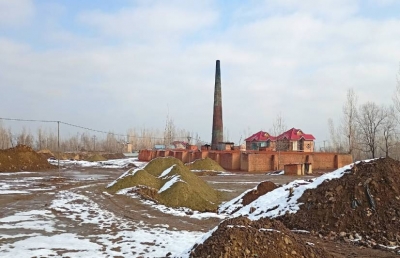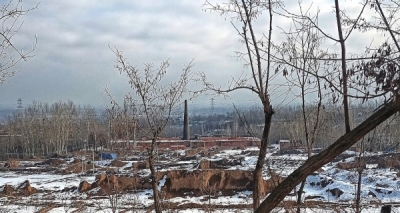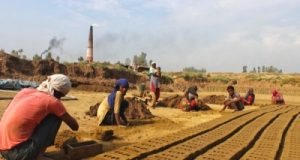

 By Mukhtar Dar
By Mukhtar DarBudgam, Feb 20 (IANS/ 101 Reporters) The lush green paddy fields of Budgam district were once a part of central Kashmirs exhilarating landscape. Most of it has been lost to the smoke-churning chimneys, dust-spewing tipper trucks and brick loads lined up across the village fields.
Of the 282 brick kilns operating in the Valley, 232 are situated in Budgam district, thanks to the ample clay content in its soil (Source: State Pollution Control Committee and District Commissioner Office Budgam). Some reports, however, suggest that the actual numbers are much higher than the official data.
According to the Directorate of Agriculture (Kashmir), 282 brick kilns function on 4,447 kanals of agricultural land in Kashmir. Nowadays, two kanals (0.25 acres) on lease for a minimum period of five years would fetch a farmer Rs 36,000 per annum.
Once the main crop, paddy cultivation has come down drastically in the district over the last few decades. The easy availability of PDS rice at nominal prices aided the change, besides leasing of land to brick kilns.
With brick manufacturers giving them a new income source, farmers recklessly leased out their fields, unaware of its adverse effects on the flora and fauna and public health. Take the case of Munzoor Ahmad Dar who leased out his land in Danseera village to a brick kiln owner in 2015. When the lease expired, he realised that the land was no longer suitable for cultivation. He had no option but to lease it out again for five years.
“The fertile surface soil is lost as brick units turn it into their raw material. Afterwards, we have to spend a lot of money on fertilisers to get yield. Even the topography of my fields has completely changed. There are soil heaps at some places and pits formed due to digging in other spots,” said Wali Mohammad of Malpora, whose father had leased the land.
Explaining the loss of soil fertility, Dr Aejaz Dar, an assistant professor at Sheri Kashmir University of Agriculture in Srinagar, told 101Reporters that 40 to 50 cm of upper soil played an important role in the growth of crops. “This soil is used extensively for making bricks, thus leaving behind dust that can only be used for construction/non-agricultural activities. Brick kilns alter the nature of even the adjacent fertile lands as they constantly emit heat and lower the water storage capacity. The heat also reduces the amount of organic matter and organic carbon, which are essential for soil fertility.”
Aejaz was of the opinion that such land could not be recovered for agriculture if the digging continued in the same pattern for long. However, he suggested that they can be used for construction, livestock grazing or forest plantations after filling with soil. “The success rate will be below 25% only,” he estimated.
Earlier, bricks were made locally in koondieh (makeshift kilns). With new avenues of wealth opening up before Kashmiris in the succeeding decades, a construction boom gripped the Valley and increased the demand for bricks. As part of the lucrative business, labourers were brought in from other states. Right now, traditional kilns rarely exist in Kashmir.
Sajad Dar pointed to the deep nexus between the administration and brick kiln owners. He said migrant labourers were transported to the kilns without paying heed to quarantine rules during the COVID-19 days.
“They got labourers for meagre wages during the pandemic. On the other hand, brick price spiked to Rs 32,000 per truckload (around 3,000 bricks) from the pre-pandemic rate of Rs 21,000, thus attracting more people into it,” he informed.
Brazen violation of rules
Tippers carrying bricks and dust are a common sight in Otligam, Danseera, Naslapora and Charangam. As per the guidelines, a brick kiln can operate only on land that is unfit for agriculture. However, almost all of the brick kilns in Budgam are built on agricultural lands. “People with financial resources have set up such kilns without permits,” alleged Sajad Dar, an advocate and president of Anti-Brick Kiln Movement.
An official at the District Commissioner’s Office conceded that all the brick kilns in Budgam were operating without a licence or had an expired one. “Of the 232 kilns, 86 function within the eight km radius of Srinagar airport’s runway. They will be cleared soon,” he added.
In 2019, the Jammu and Kashmir High Court had directed that no brick kiln be permitted to operate or take up any activity within the eight km radius of the airport. Of the rest 146 operating in other parts of Budgam, 124 have expired licenses and 22 do not even have a licence.
Asked about violations under the brick kilns regulation Act, the official replied that they were giving permissions after getting consent from the Pollution Control Board (PCB) and nine other departments that are supposed to check that the units adhered to all parameters. “It is their duty to check,” he claimed.
He added that the District Commissioner has constituted committees to check the brick kiln licenses at the sub-district magistrate level, and several FIRs have been registered against the violators, leading to the demolition and sealing of brick kilns.
The Jammu and Kashmir Brick Kilns (Regulation) Act, 2010, oversees and controls the building of brick kilns in the Union Territory and addresses any difficulties that may emerge during the process. However, not one section has been properly imposed.
For example, approval from 10 departments, including health, agriculture and irrigation, is needed to set up a brick kiln. However, Ahmad claimed the kilns built on agricultural lands by wealthy individuals have been functioning for around a decade without any licence. “How can the agriculture department permit such kilns on lands that have been the source of rice for so many years,” he questioned.
“We never gave any permission to build brick kilns on agricultural lands,” retorted Chief Agricultural Officer Syed Tafazul Hussain, when asked about it. “Recently, a complaint about chopping down of almond trees was raised before us… When my consent was sought for building the kiln, I utterly rejected it. A few files did reach my office, but I never approved any of them,” he replied emphatically.
Awareness matters
Residents of Malpora and Otligam make up most of the Anti-Brick Kiln Movement members. Noticing that the operation of brick kilns have devastated agricultural lands, 10 local youth came together in January 2021 and vowed to protect other villages from a similar disaster.
“Initially, we organised public meetings to create awareness on the adverse effects of these kilns on soil fertility, cultivation and people’s health. From several hamlets, we chose youth to educate people, particularly landowners,” Rayees Dar, a socio-environmental activist and chairman of Anti-Brick Kiln Movement, told 101Reporters.
In the last two years, the activists have conducted about 100 meetings. They also keep an eye on new illegal brick kilns coming up in the neighbourhood, and make frequent enquiries with the divisional commission, PCB, geology and mining department, district administrator and tehsildar, to name a few.
“I am glad that we have prevented illegal construction of over eight brick kilns in Malpora, Otligam, Gampora, Gundipora, Narwara, Mulshula, Bapat, Saihoma and many other villages. Our efforts have saved 250 acres of cultivable land from destruction,” Rayees exuded confidence.
In 2021, around 18 acres in Malpora were given on lease to brick kilns owners. To stop the establishment of kilns there, the movement members organised a meeting with landowners and educated them about the long-term consequences. While some changed their minds, others remained adamant.
“As we failed to persuade everyone, we moved the munsiff court of Magam Beerwah and got a stay on construction. Finally, the investor had to shelve the project as he knew that all the laws were against him,” Rayees said.
It is no surprise that those who stand up against such illegal activities face threats and suppression. Government school teacher Javaid Ahmad Wani was in the forefront of protests against a brick kiln operational in Mirpora. “After a few days, I was transferred to work under an official at the district commissioner’s office in Budgam. It was a sort of punishment,” Wani told 101Reporters, implying that this was done at the behest of kiln owner.
When asked about it, Budgam’s Chief Educational Officer Mustaq Qadri simply said, “I did not know about it. I will enquire.”
(Mukhtar Dar is a Budgam based freelance journalist and a member of 101Reporters, a pan-India network of grassroots reporters, where this article was originally published)
–IANS
arm/










